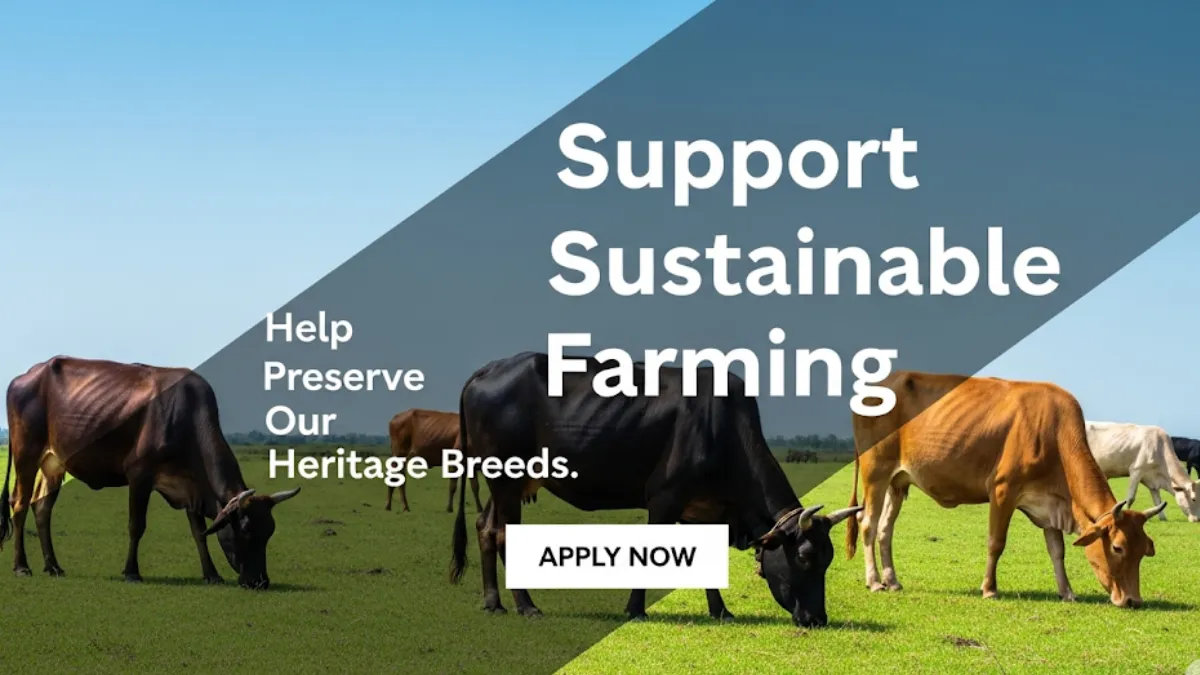Uttar Pradesh government has launched a new scheme called Mukhyamantri Svadeshi Gau Samvardhan Yojana. This scheme aims to increase the number of high-quality indigenous cows in the state, promote dairy farming, and provide new employment opportunities, especially for youth and women in rural areas. The new scheme is similar to the earlier UP Gopalak Yojana but focuses more on indigenous breeds and increasing the overall milk production.
What is Mukhyamantri Svadeshi Gau Samvardhan Yojana in UP?
Mukhyamantri Svadeshi Gau Samvardhan Yojana is launched to encourage dairy farmers to bring good quality indigenous (svadeshi) cows from other states into Uttar Pradesh. The main focus is to:
- Increase the number of high-yielding Indian breeds.
- Improve the quality and productivity of local cattle.
- Support the state’s dairy sector and rural employment.
The government will give grants and support to farmers who buy and rear indigenous high-quality cows from states like Gir, Sahiwal, Haryana, Tharparkar, and their crossbreeds.
Scheme Highlights
| Feature | Details |
|---|---|
| Scheme Name | Mukhyamantri Svadeshi Gau Samvardhan Yojana |
| Earlier Name | Gopalak Yojana |
| Launched By | Government of Uttar Pradesh |
| Who Can Apply | Dairy farmers, rural youth, women, unemployed persons |
| Main Objective | Increase indigenous cow breeds and boost milk production |
| Support/Benefit | Grant for buying cows, transport, insurance, shed, chaff cutter, etc. |
| Number of Cows per Unit | 2 indigenous high-quality cows (Gir, Sahiwal, Haryana, Tharparkar, etc.) |
| Maximum Support per Unit | Up to ₹80,000 (40% of estimated cost, unit cost ₹2 lakh) |
| Animal Insurance | Free for 3 years |
| Application Mode | Online / through local veterinary officials |
| Target Groups | Preference to women and youth in villages |
Main Objectives of the Svadeshi Gau Samvardhan Yojana
- Increase Indigenous Cows: Grow the number of high-quality Indian breed cows in the state and improve their breed.
- Boost Milk Production: Raise the state’s milk output to match or exceed the national average.
- Create Jobs: Encourage rural youth and women to take up dairy farming and self-employment.
- Bring More High-Quality Cows: Help farmers to bring better breed cows from other states, ensuring a sustainable dairy business.
Key Features and Benefits of Mukhyamantri Svadeshi Gau Samvardhan Yojana
- Grant for Cow Purchase: The government gives a grant (up to 40% of unit cost) for buying high-quality indigenous cows.
- Support for Transport & Insurance: Cost for bringing cows from other states, animal transit insurance, and 3 years of animal insurance is covered.
- Infrastructure Support: Shed construction, chaff cutter machine for feed preparation, and other support included in the grant.
- Women & Youth Priority: 50% of benefits are reserved for women; youth and new entrepreneurs are also encouraged.
- Unit Size: Each applicant can get support for buying 2 cows in one unit.
- Veterinary & Extension Services: Local animal husbandry units and officers will provide guidance and monitoring.
- Selection Process: Transparent selection through district committees and (where applicable) e-lottery.
Who Can Apply (Eligibility Criteria)
- Must be a permanent resident of Uttar Pradesh.
- Age 18 years or above.
- Should have enough space/shed for keeping cattle.
- Should not already own more than 2 indigenous high-quality cows (Gir, Sahiwal, Haryana, Tharparkar, or crossbreed).
- Preference to new dairy farmers, rural youth, and women.
- The applicant must agree to rear only indigenous cows and not crossbreed (exotic) or Jersey cows under this scheme.
Documents Required
- Aadhaar Card (self-attested copy)
- Residence Certificate of UP
- Bank Account Details
- Passport-size Photograph
- Proof of shed/space for cattle
- Self-declaration / affidavit of not owning more than 2 eligible cows
- Other documents as required by the district veterinary office
How to Apply for Mukhyamantri Svadeshi Gau Samvardhan Yojana
- Application Form: Visit the nearest veterinary officer or district animal husbandry office to get the application form PDF. In future, the process may shift online.
- Fill the Form: Fill in all required details and attach the necessary documents.
- Submit: Submit the form to the same office or through the online portal (if available).
- Selection: District committee will review applications, and eligible applicants will be chosen (sometimes via e-lottery if applications are more than the set target).
- Verification: Selected applicants will be verified and guided for cow purchase and shifting.
- Grant Distribution: Once the cows are brought and installed, grant money is released as per the set heads (purchase, transport, insurance, shed, equipment).
Selection Process
- 50% of beneficiaries will be women.
- Selection is transparent, done at the district level.
- Preference to those not already benefitting from other cattle schemes.
- Final list published online/notice boards.
- If more applications than the target, e-lottery will be conducted.
- After selection, beneficiaries must bring cows within 2 months and get them tagged/chipped for identity.
FAQs
Is this Svadeshi Gau Samvardhan Yojana different from the old Gopalak Yojana?
Yes, the focus is now on indigenous breeds and increasing their numbers, while Gopalak Yojana was open to both cows and buffaloes.
Can I buy cows from any state?
Yes, you can bring eligible Indian breed cows from other states (like Gujarat, Haryana, Rajasthan).
What is covered in the grant?
Cow cost, transport, insurance, shed, equipment—everything is included up to ₹80,000 per unit.
Can I apply for more than 2 cows?
No, the scheme supports 2 cows per unit per applicant.
Who to contact for more help?
Contact your local veterinary officer or district animal husbandry office.
